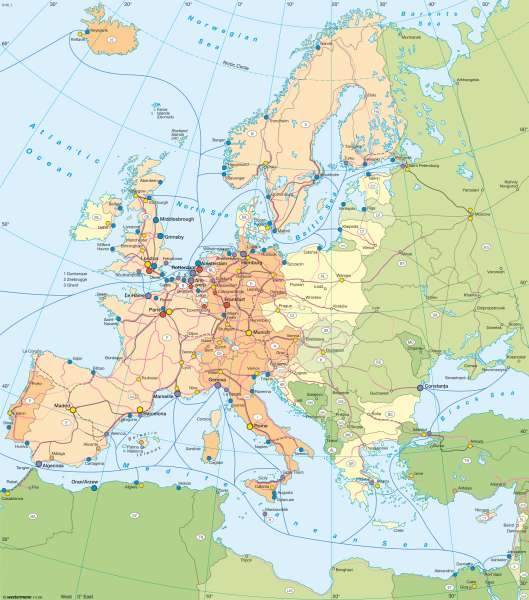Europa — Long distance traffic
Europe - Transport
978-3-14-100790-9 | Page 54 | Ill. 1

Information
The transport infrastructure of the European Union (EU) is one of the Community's major assets. A well-developed transport network ensures the fastest possible transport of passengers and freight and thus the economic cohesion of the region, which has grown continuously in the last few decades.The 27 member states of the EU possess over five million kilometres of surfaced roads, including nearly 62,000 kilometres of motorway. Out of just over 215,000 kilometres of railway line, 107,000 kilometres are electrified. In addition, 41,000 kilometres of rivers and canals are navigable by inland shipping. 859 billion euros were invested in these routes between 2000 and 2006 alone. To these must be added numerous airports, some of which are among the most important in the world.
Elements and Structure
The core economic zone of the EU is demarcated by four cities: London, Paris, Frankfurt am Main and Amsterdam. These four cities — together with Madrid — also have the five largest airports in the EU. They form a rectangle that contains, for example, the Ruhr Area as the largest multi-centre conglomeration and Brussels as the political hub of the EU, as well as a large number of the North Sea ports between Le Havre and Hamburg.
The EU has high-capacity ports on all its coasts. As well as Rotterdam and Hamburg on the North Sea, these include for example Gda?sk and Helsinki on the Baltic, Bilbao and Sines on the Atlantic, and Marseille and Genoa on the Mediterranean. Thanks to the fact that these ports are connected with the most important container routes, the EU is guaranteed top-quality transport by water.
The quality of the roads and the importance of the automobile in the EU member states are shown on the map by means of vehicle density. The density is greatest in the core region, which stretches from Germany to Italy — with the exception of Portugal as an "outlier" — beside which there is a gap with the western countries tending to have more cars per inhabitant than the countries of the former Warsaw Pact.
A similar picture can be seen in the density of the rail network, although here the relatively new lines belonging to the high-speed network in particular permit a differentiated picture. Outstanding roles are played by France with its TGV network focused on Paris, and Germany with its ICE routes.
Strategies for the Future
A major task for the EU will be to bring its eastern and south-eastern members up to the standards of the other states. The example of the three Baltic states — Lithuania, Latvia and Estonia — shows that for the railway network it is not yet a question of creating high-speed connections, but firstly of modernizing existing lines, where in many cases speeds above 120 km/h are not yet possible (Rail Baltica).
The work is being coordinated by the Trans-European Transport Network Executive Agency (TEN-T EA), which was set up by the European Commission. It is the agency's responsibility to close existing gaps and remove bottlenecks. From 2007 until 2020, a further 500 billion euros will be made available for this purpose, 270 billion euros of which will be allocated to the 30 most important projects. These include for example the high-speed axis in south-western Europe, the rail connections to the Ukrainian border from Lyon via Trieste and from Ljubljana via Budapest, the freight transport connection from Sines to Paris via Madrid, and the motorway connection from Gda?sk to Vienna and Bratislava via Brno.
D. Falk; Ü: J. Attfield




